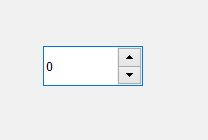QSpinBox es un widget de PyQt5 que presenta al usuario un cuadro de texto que muestra un número entero con un botón arriba/abajo a la derecha. El valor en el cuadro de texto aumenta/disminuye si se presiona el botón arriba/abajo. El valor mínimo predeterminado es 0 y el valor máximo es 99.

Ejemplo:
una ventana que tiene un Spinbox, cuando el valor cambia, aparecerá un mensaje que muestra el valor actual.
Pasos para la implementación –
1. Cree una clase de ventana principal
2. Cree un widget de cuadro de número
3. Cree una etiqueta para mostrar el valor
4. Agregue una acción al cuadro de número de modo que cuando se cambie el valor se llame a
la acción 5. Dentro de la acción establezca el valor en la etiqueta
A continuación se muestra la implementación.
# importing libraries
from PyQt5.QtWidgets import *
from PyQt5 import QtCore, QtGui
from PyQt5.QtGui import *
from PyQt5.QtCore import *
import sys
class Window(QMainWindow):
def __init__(self):
super().__init__()
# setting title
self.setWindowTitle("Python ")
# setting geometry
self.setGeometry(100, 100, 600, 400)
# calling method
self.UiComponents()
# showing all the widgets
self.show()
# method for widgets
def UiComponents(self):
# creating spin box
self.spin = QSpinBox(self)
# setting geometry to spin box
self.spin.setGeometry(100, 100, 100, 40)
# adding action to the spin box
self.spin.valueChanged.connect(self.show_result)
# creating label show result
self.label = QLabel(self)
# setting geometry
self.label.setGeometry(100, 200, 200, 40)
# method called by spin box
def show_result(self):
# setting value of spin box to the label
self.label.setText("Value : " + str(self.spin.value()))
# create pyqt5 app
App = QApplication(sys.argv)
# create the instance of our Window
window = Window()
window.show()
# start the app
sys.exit(App.exec())
Producción :
Publicación traducida automáticamente
Artículo escrito por rakshitarora y traducido por Barcelona Geeks. The original can be accessed here. Licence: CCBY-SA